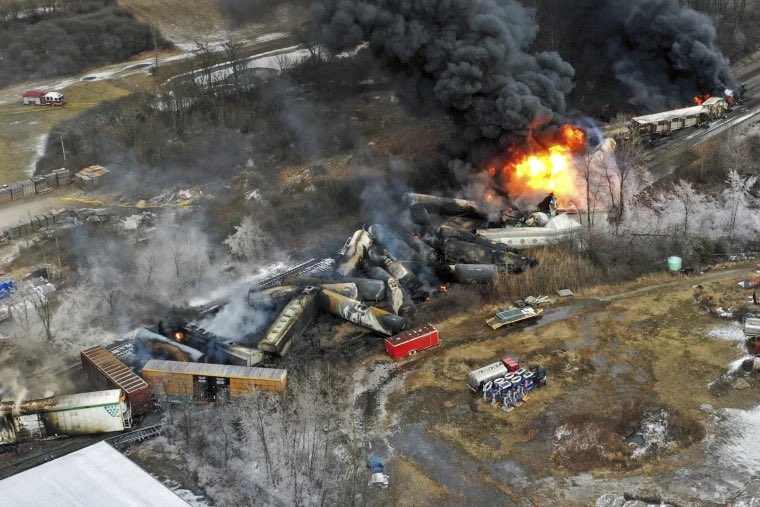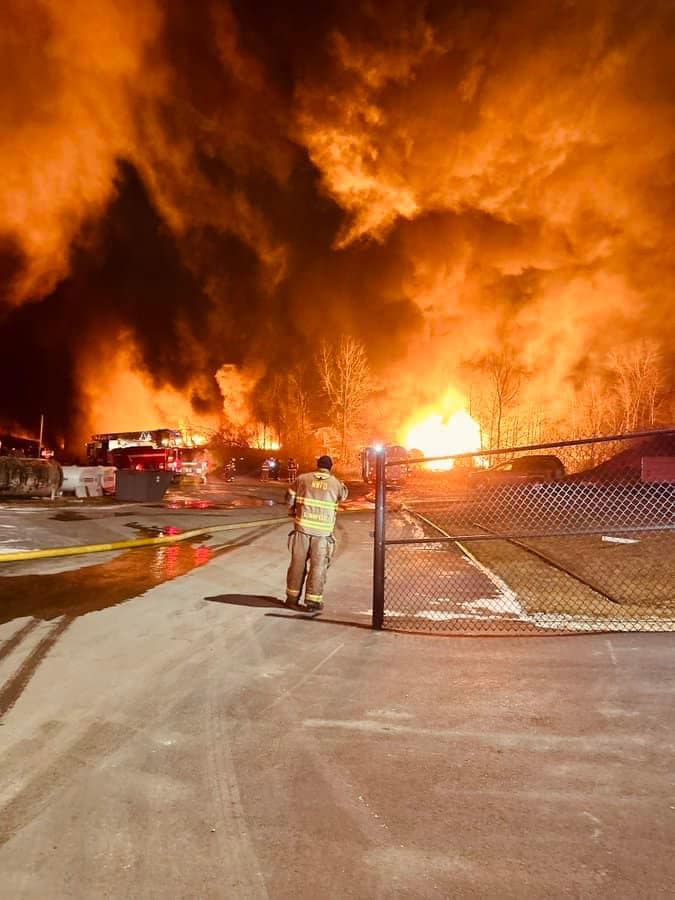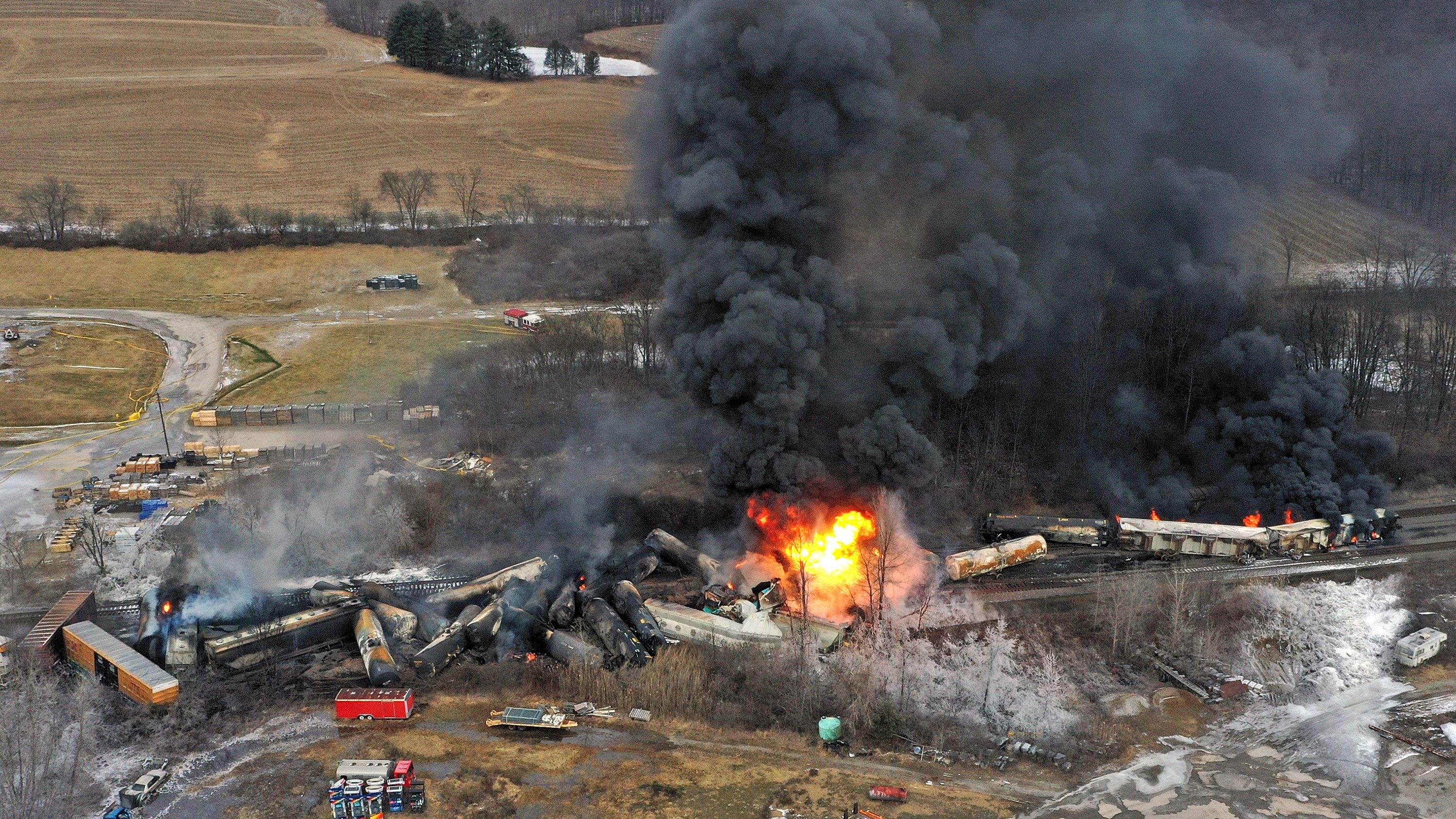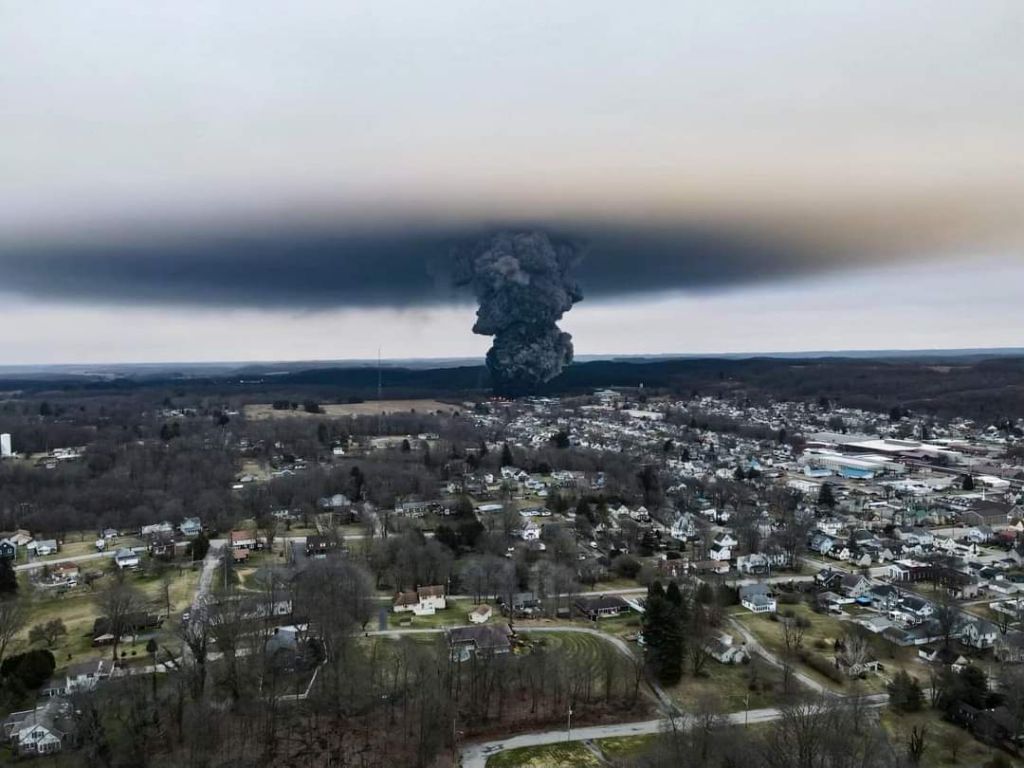The toxic chemistry of the Ohio trainwreck that forced people to leave town forever

The controlled burning and release of toxic chemicals is underway in Ohio, following the derailment of a train carrying noxious chemicals. We take a look at what exactly it is that the train was carrying and just how harmful they can be.
A train carrying vinyl chloride derailed and exploded near the Ohio-Pennsylvania border and authorities ignited a controlled burning of toxic chemicals to prevent a much more dangerous explosion.
THREAD: Photos, videos, and news reports about the train derailment and toxic chemical release in East Palestine, Ohio.
— kanekoa.substack.com (@KanekoaTheGreat) February 13, 2023
This may be the largest environmental disaster in U.S. history.
🧵👇 pic.twitter.com/0qgtdpN7fQ
This means that they intentionally released certain chemicals from the site in a controlled manner to prevent any unexpected or uncontrolled release that could cause harm to people or the environment.

The science behind this decision involves around the analysis of the chemical properties of the substances involved in the derailment and the potential risks associated with their release. The authorities would have identified the chemicals and their physical and chemical characteristics, such as volatility, flammability, toxicity, and reactivity, among others, to determine the safest way to remove them.

The process of venting these pressurized chemicals involves the controlled release of the gas through a venting system. This system is designed to ensure that the gas is safely released into the atmosphere without causing harm to people or the environment.

However, if the venting system is not properly designed, operated, or maintained, it can lead to the release of large amounts of vinyl chloride into the surrounding environment. This can result in harmful effects on the health of nearby populace and the environment.

Exposure to high levels of these chemicals can cause a range of harmful effects on human health and can cause air and water pollution, which can harm plants and animals and contaminate food sources.
Here’s are the various chemicals the train was carrying before going off the rails:
Vinyl Chloride
Vinyl chloride is a colorless, flammable gas that is widely used in the production of polyvinyl chloride (PVC) plastic. When vinyl chloride is pressurized, it can become unstable and can potentially explode.
Uses:
- Vinyl chloride is used to make PVC, which is used in a variety of products such as pipes, wire coatings, flooring, and medical devices.
- It is also used as a refrigerant and in the production of other chemicals.
Harmful effects:
- Vinyl chloride is classified as a human carcinogen, meaning it can cause cancer. Long-term exposure to high levels of vinyl chloride can increase the risk of liver cancer and other health problems.
- Short-term exposure to high levels of vinyl chloride can cause dizziness, headache, and drowsiness.
- It can also cause skin irritation and chemical burns if it comes into contact with the skin or eyes.
- Vinyl chloride is harmful to the environment and can contaminate soil and water if it is not properly disposed of.
Benzene
Benzene is a colorless, flammable, and toxic liquid that belongs to the family of organic compounds called aromatics. It has a sweet smell and is commonly used as a solvent, starting material for chemical synthesis, and a constituent in gasoline and other fuels.
Uses:
- As a solvent in industries such as rubber, textile, and pharmaceuticals.
- As a starting material for the production of chemicals such as styrene, phenol, and nylon.
- As a constituent in gasoline and other fuels.
- In laboratory settings as a reagent.
Harmful effects:
- Benzene is a known carcinogen and exposure to high levels of benzene can cause cancer, particularly leukemia and lymphoma.
- It can also cause damage to the central nervous system, bone marrow, and other organs.
- Short-term exposure to high levels of benzene can cause symptoms such as dizziness, headaches, and nausea.
- Benzene is harmful to the environment and can contaminate soil and groundwater.
Ethylene glycol monobutyl ether (EGMBE)
Ethylene glycol monobutyl ether (EGMBE) is a colorless liquid with a faint, ether-like odor. It is commonly used as a solvent in various industrial and household products.
Uses:
- EGMBE is used as a solvent in various applications, such as coatings, inks, cleaning agents, and chemical processing.
- It is also used as a component in brake fluids, hydraulic fluids, and antifreeze formulations.
- In the household, EGMBE can be found in some cleaning products and paint thinners.
Harmful effects:
- EGMBE can cause irritation to the eyes, skin, and respiratory system.
- Prolonged exposure to high concentrations can lead to more serious health effects, including central nervous system depression, kidney and liver damage, and reproductive toxicity.
- It is also harmful if ingested, and can cause gastrointestinal distress and damage to internal organs.
Butyl acrylate
Butyl acrylate is a colorless, flammable liquid with a fruity odor. It is soluble in most organic solvents and slightly soluble in water.
Uses:
- Butyl acrylate is mainly used as a monomer to produce polymers, such as homopolymers and copolymers. It is used in the production of adhesives, coatings, and paints.
- It is used as a reactive diluent for UV-curable systems, such as inks and coatings.
- It is also used as a solvent for polymers, resins, and other chemicals.
Harmful effects:
Butyl acrylate is a skin and eye irritant. It can cause skin burns, skin sensitization, and allergic reactions. Inhalation of butyl acrylate vapors can cause respiratory irritation, coughing, and difficulty breathing. Chronic exposure to butyl acrylate can cause liver and kidney damage. It is also classified as a carcinogen, and prolonged exposure can increase the risk of cancer.
Safety measures:
The use of protective gloves, goggles, and respiratory masks is necessary while handling butyl acrylate. It should be stored in a cool, dry, and well-ventilated area. The storage area should be kept away from heat sources, sparks, and flames. The spillage of butyl acrylate should be immediately cleaned up to prevent contamination. The transportation of butyl acrylate should be done in accordance with local and international regulations.
Ethylhexyl acrylate
Ethylhexyl acrylate is a clear and colorless liquid chemical with a sweet odor. It is a versatile chemical that finds application in several industries, including coatings, adhesives, inks, and textiles.
Uses:
- It is used as a reactive diluent in coating formulations to improve the performance of the coating.
- It is used as a monomer in the production of pressure-sensitive adhesives.
- Ethylhexyl acrylate is used in the textile industry as a co-monomer in the production of synthetic fibers.
Harmful effects:
- Contact with the skin or eyes can cause irritation and inflammation.
- Inhalation of vapors can cause respiratory problems such as coughing, wheezing, and shortness of breath.
- Ethylhexyl acrylate is classified as a possible human carcinogen by the International Agency for Research on Cancer.
- Ethylhexyl acrylate is toxic to aquatic organisms and can cause harm to the environment if released in large quantities.
Isobutylene
Isobutylene is a colorless, highly flammable gas with a sweet odor. It is used in the production of various chemicals, including butyl rubber, isooctane, and methyl tertiary butyl ether (MTBE).
Uses:
- Isobutylene is the main feedstock for the production of butyl rubber, which is used in tires, inner tubes, and other automotive and industrial products.
- It is used as a fuel additive in gasoline to improve its octane rating and reduce engine knock.
- Isobutylene is also used as a refrigerant in air conditioning and refrigeration systems.
Harmful effects:
- Isobutylene is highly flammable and can form explosive mixtures with air.
- Isobutylene is a simple asphyxiant and can displace oxygen in poorly ventilated areas, leading to asphyxiation.
- It can also cause irritation to the eyes, skin, and respiratory system.
- Isobutylene is a volatile organic compound (VOC) that can contribute to air pollution and smog formation. It is also harmful to aquatic life and can contaminate groundwater if released into the environment.
In addition to these, the East Palestine community in Ohio of roughly 5,000 inhabitants, was evacuated by thousands after officials issued a warning that the controlled fire would spread a plume of phosgene and hydrogen chloride throughout the area. Phosgene, a very toxic gas that may make people throw up and have breathing difficulties, was a weapon in the First World War.
Despite the fact that no one was killed in the incident, public health activists caution that it should serve as a warning about the possibility of other disastrous freight rail derailments.
East Palestine residents sceptical about returning
After the derailment, federal and local officials repeatedly told residents that the air quality was safe and that the water supply was untainted, but, more than a week after the incident, residents were sceptical to return to their houses. Some residents told The Washington Post that they had yet to see a full list of the chemicals that were aboard the train when it lost its course.
Residents and experts told The Post that they question whether it is safe to return to their homes a week after contaminants flowed into local streams and spewed into the air. Some experts said that it was unclear whether the agency had enough data when it told residents the air was safe.

